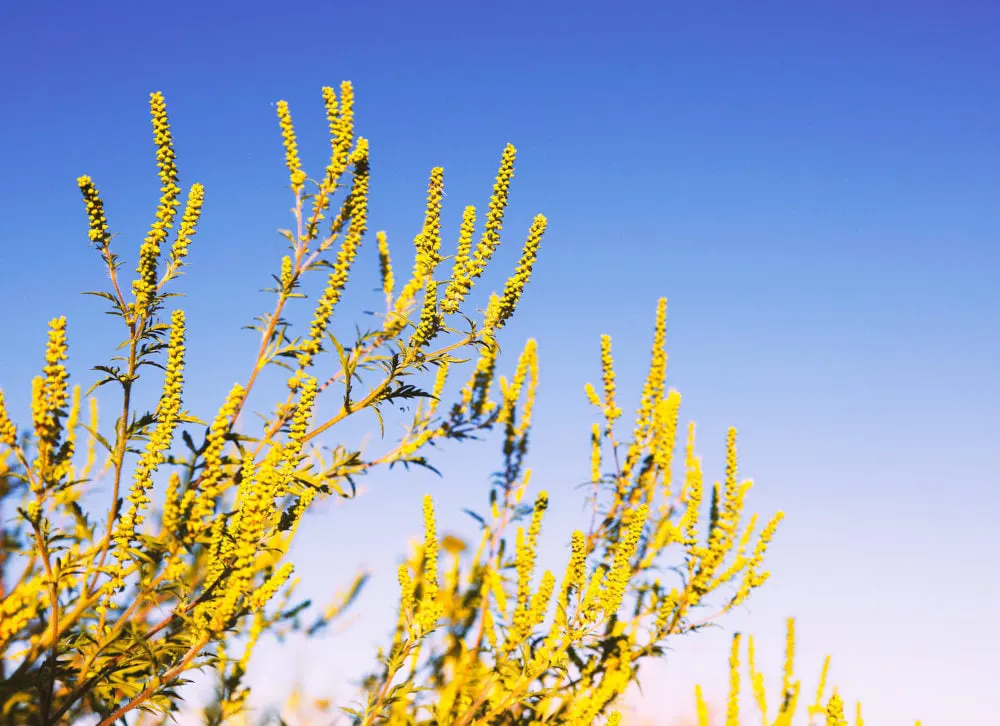What Is Ragweed?
Ragweed is a weed that lives in every state except Alaska. It can grow in many different types of soil, and it’s often found in roadside ditches and vacant lots. Ragweed plants only live for one season, but they can pack a punch for allergy sufferers — a single plant can pump out up to 1 billion pollen grains into the air!1
What Does Ragweed Look Like?
There are two types of ragweed - common and giant ragweed.
Common ragweed has hairy, distinctively shaped fern-like leaves, with green flowers at the ends of its branches. Mature plants can grow up to six feet tall.2

Common Ragweed Leaf. Photo credit: https://commons.wikimedia.org/wiki/File:Common_Ragweed_leaf_(2976017730).gif#filelinks

Common Ragweed Flowers. Photo credit:
https://commons.wikimedia.org/wiki/File:Ambrosia_artemisiifolia_-_Common_Ragweed.jpg
Giant ragweed grows up to 12 feet tall, about double the height of common ragweed. The stems and leaves are rough with deep lobes.3

Giant Ragweed Plant. Photo credit: https://commons.wikimedia.org/wiki/File:Giant_Ragweed_(Ambrosia_trifida)_6865.jpg

Giant Ragweed Flowers. Photo credit: https://commons.wikimedia.org/wiki/File:Flowers_of_giant_ragweed.jpg
Another plant called goldenrod often gets the blame for fall allergies, but it’s a case of mistaken identity — goldenrod looks similar to ragweed but doesn’t cause allergies. Both are found in roadside ditches and open fields, and the flowers bloom at the same time. You can tell them apart by looking at the flowers — goldenrod has bigger, bright yellow flowers that are pollinated by insects, and ragweed has small flowers that are pollinated by the wind.4

Goldenrod. Photo credit: https://commons.wikimedia.org/wiki/File:20190816Solidago_canadensis.jpg
Where Does Ragweed Grow?
Ragweed is a weed that grows throughout most of the U.S., especially in the eastern and midwestern states. It is found in every state except for Alaska. Even if you don’t live near the plant, avoiding it is difficult — ragweed pollen can travel in the wind for long distances. It has even been found in the air 400 miles out to sea and two miles up into the atmosphere.1
When Is Ragweed Pollen Season?
Ragweed starts producing pollen in August and ragweed allergies can persist through September and October, but ragweed season can start as early as July depending on where you live. The pollen can stay in the air as late as November. The pollen levels peak in the mornings, so it helps to plan your outdoor activities in the afternoons or evenings to avoid it.5 On rainy days or cooler mornings, the plants produce less pollen.1
What Is a Ragweed Allergy?
If you have a ragweed allergy, your immune system is overreacting to pollen in the air. It triggers your immune system to fight it off like an invader, and it can cause you to develop bothersome allergy symptoms in the fall time. Keep reading to learn more about allergy symptoms and treatments.
Ragweed Allergy Symptoms
Ragweed is one of the most common triggers of seasonal allergies.6 If you have a ragweed allergy, you can have symptoms that can make you miserable during the fall when it is highest in your area. Symptoms can include:
Runny nose
Sneezing
Stuffy nose
Coughing
Itchy eyes, nose, or throat
Mucus flowing behind the nose into the throat
Ragweed Allergy Treatment
Managing ragweed allergies can make a big difference in how you feel. Here are some steps you can take to prevent symptoms:
Find out when ragweed season peaks in your area, and limit outdoor activities when ragweed pollen is high.
Ragweed pollen is highest in the morning. Plan outdoor activities during the afternoon and evening.
If you’ve been outdoors, bathe and wash your clothes as soon as you can. Ragweed pollen can stick to you and trigger symptoms.
Keep your windows closed and use a HEPA filter or air conditioner to reduce the ragweed in your home.
You might want to mask up in the fall or when ragweed pollen is highest in your area. A mask makes a physical barrier to the pollen that can help prevent it from causing your allergy symptoms in the first place.
Ragweed pollen is similar to proteins in some foods. If you have a condition called oral allergy syndrome (OAS), certain foods can trigger your mouth to tingle and itch.7 The most common foods are bananas, cantaloupe, cucumber, honeydew, sunflower seeds, watermelon, white potato, and zucchini.1 Talk to your doctor if you think you have OAS or food allergies.
If you have a ragweed allergy, treatment with medication can help provide relief from symptoms. Some ragweed allergy treatment options include:
Nasal irrigation with a saltwater solution can rinse out pollen grains and clear out mucus from your sinuses. You can buy nasal irrigation kits over the counter. A convenient time to rinse your sinuses is during your shower.
Nasal sprays that are available over the counter and by prescription can help reduce symptoms. Steroid nasal sprays can reduce inflammation, and decongestant nasal sprays can help with a stuffy nose.
BENADRYL® and other antihistamines can help relieve ragweed allergy symptoms. BENADRYL® Allergy ULTRATABS® Tablets and BENADRYL® Allergy Dye-Free LIQUI-GELS® have 25 mg of the antihistamine diphenhydramine. BENADRYL® Allergy Plus Congestion ULTRATABS® contain 25 mg diphenhydramine and 10 mg of phenylephrine, a nasal decongestant to help with sinus congestion. For children ages 6 years and older, consider Children’s BENADRYL® Allergy Plus Congestion Medicine for an antihistamine and decongestant combination medicine.
References
Asthma and Allergy Foundation of America. Ragweed Pollen Allergy. August 2019. Accessed from: https://www.aafa.org/ragweed-pollen/
Cornell University. Common Ragweed. Accessed from: https://blogs.cornell.edu/weedid/field-crops/common-ragweed-ambrosia-artemisiifolia/
Iowa State University. Common Ragweed. Accessed from: https://crops.extension.iastate.edu/encyclopedia/giant-ragweed
Clemson Cooperative Extension Home and Garden Extension. How to Tell the Difference Between Goldenrod and Ragweed. September 10, 2018. Accessed from: https://hgic.clemson.edu/how-to-tell-the-difference-between-goldenrod-and-ragweed/
Asthma and Allergy Foundation of America. 7 Things You May Not Know About Ragweed Pollen Allergy. August 2021. Accessed from: https://community.aafa.org/blog/6-things-you-may-not-know-about-ragweed-pollen-allergy
Mayo Clinic. Hay Fever. July 16, 2020. Accessed from: https://www.mayoclinic.org/diseases-conditions/hay-fever/symptoms-causes/syc-20373039
American Academy of Allergy, Asthma, and Immunology. Oral Allergy Syndrome. September 28, 2020. Accessed from: https://www.aaaai.org/tools-for-the-public/conditions-library/allergies/oral-allergy-syndrome-(oas)

